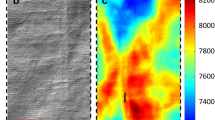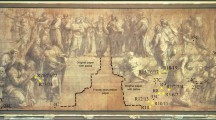Abstract
The reddish-brown, brown or yellowish stains of circular or irregular shape known as foxing spots have been fully described in conservation literature but still, this phenomenon does not find any scientific agreement since many hypotheses have been raised concerning their origin. In this work a contribution to foxing definition not only focussed on its appearance but also reported on its chemical information. For this purpose foxing stains present in drawings from two Portuguese artists dated from the eighteenth to nineteenth centuries were observed under ultra-violet light and optical microscope and analysed by three non-invasive spectroscopy techniques. The observations carried out on the stains provided information on their surface morphology. The use of energy-dispersive X-ray fluorescence revealed a variation on the elemental content between foxing and paper region. Although the results from X-ray diffraction analysis showed no signs of cellulose degradation in foxing stains, Fourier-transformed infrared analysis revealed the presence of oxide groups. Both the information on the chemical nature and surface morphology of the stains achieved in this study will contribute to increase foxing formation information and develop future protocols for conservation purposes.




Similar content being viewed by others
References
Derow J, Owen A (1992) In: Paper conservation catalog, American Institute for Conservation Book and Paper Group, Foxing, Washington, D.C.: AIC. Chap.13:1–39
Choi S (2007) Foxing on paper: a literature review. J Am Inst Conserv 46:37–152
Ligterink FJ, Porck HJ, Smith WJ Th (1991) Foxing stains and discolouration of leaf margins and paper surrounding printing ink: elements of a complex phenomenon in books. The Paper Conservator, IPC, 15:45–52
Rebrikova NL, Manturovskaya NV (2000) Foxing: a new approach to an old problem. Restaurator 21:85–100
Bichieri M, Pappalardo G, Romano FP, Sementilli FM, Acutis R (2001) Characterisation of foxing stains by chemical a spectrometric methods. Restaurator 22:1–19
Bicchieri M, Ronconi S, Romano FP, Pappalardo L, Corsi M, Cristoforetti G, Legnaioli S, Palleschi V, Salvetti A, Tognoni E (2002) Study of foxing stains on paper by chemical methods, infrared spectroscopy, micro-X-ray fluorescence spectrometry and laser induced breakdown spectroscopy. Spectr Acta B 57:1235–1249
Florian M-LE (1996) The role of the Conidia of fungi in fox spots. Stud Conserv 41:65–75
Florian M-LE, Manning L (2000) SEM analysis of irregular fungal fox spots in an 1854 book: population dynamics and species identification. Int Biodeterior Biodegrad 46:205–220
Arai H (2000) Foxing caused by Fungi: twenty- five years of study. Int Biodeterior Biodegrad 46:181–188
Zotti M, Ferroni A, Calvini P (2008) Microfungal biodeterioration of historic paper: preliminary FTIR and microbiological analyses. Int Biodeterior Biodegrad 62:186–194
Rakotonirainy MS, Heude E, Lavédrine B (2008) Isolation and attempts of biomolecular characterization of fungal strains associated to foxing on a 19th century book. J Cult Herit 8:126–133
Choisy P, De La Capelle A, Thomas D, Legoy DT (1997) Non invasive techniques for the investigation of foxing stain of graphic art material. Restaurator 18:131–152
Pedersoli JL, Ligterink FJ, van Bommel M (2001) Investigation into fluorescence changes accompanying paper discoloration. In: ICOM—CC's Interim meeting of the working group on graphic documents at EVTEK Institute of Art and Design, pp. 7–10. Vantaa (Helsinki), Finland
Pessanha S, Manso M, Guilherme A, Costa M, Carvalho ML (2009) Investigation on historical documents for forensic purposes by X ray fluorescence analysis. Surface and Interface Analysis doi:10.1002/sia.3085
Manso M, Pessanha CML (2006) Artificial aging processes in modern papers: X-ray spectrometry studies. Spectr Acta B 61:922–928
Foner HA, Adan N (1983) The characterisation of papers by X-ray diffraction (XRD): measurement of cellulose crystallinity and determination of mineral composition. J- forensic Sci Soc 23:313–321
Lojewska J, Lubanska A, Miskowiec P, Lojewski T, Proniewicz LM (2006) FTIR in situ transmission studies on the kinetics of paper degradation via hydrolytic and oxidative reaction paths. Appl Phys A 83:597–603
Laguardia L, Vassallo E, Cappitelli F, Mesto E, Cremona A, Sorlini C, Bonizzoni G (2005) Investigation of the effects of plasma treatments on biodeteriorated ancient paper. Appl Surf Sci 252:1159–1166
Acknowledgement
This work was funded by the Portuguese Foundation for Science and Technology FCT-SFRH/BD/30259/2006 and PTDC/71998/2006 (Morphological characterisation of paper stains and treatment methodologies).
Author information
Authors and Affiliations
Corresponding author
Rights and permissions
About this article
Cite this article
Manso, M., Pessanha, S., Figueira, F. et al. Characterisation of foxing stains in eighteenth to nineteenth century drawings using non-destructive techniques. Anal Bioanal Chem 395, 2029–2036 (2009). https://doi.org/10.1007/s00216-009-3142-9
Received:
Revised:
Accepted:
Published:
Issue Date:
DOI: https://doi.org/10.1007/s00216-009-3142-9




